|
|

|
Listed below are all of the classifications and categories that appear in the UN GHS Framework, with the hazard statement and pictogram for both the GHS MSDS and the transport pictogram's.
|
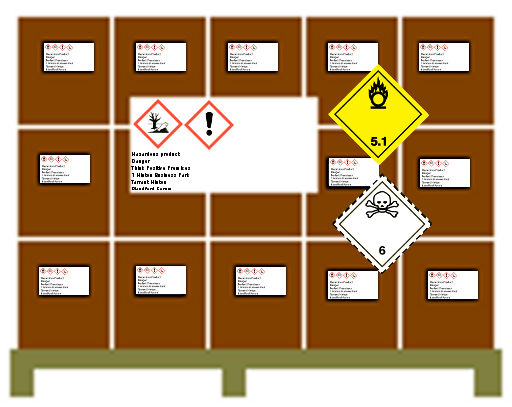 |
| Classification & Category | Signal Word | Hazard statement | Pictograms | ||
|---|---|---|---|---|---|
| GHS/CLP | Transport | ||||
| Unstable Explosive | Danger | H200 | Unstable explosive. |  |
|
| Explosive 1.1 | Danger | H201 | Explosive; mass explosion hazard. |  |
 |
| Explosive 1.2 | Danger | H202 | Explosive; severe projection hazard. |  |
 |
| Explosive 1.3 | Danger | H203 | Explosive; fire, blast or projection hazard. |  |
 |
| Explosive 1.4 | Warning | H204 | Fire or projection hazard. |  |
 |
| Explosive 1.5 | Danger | H205 | May mass explode in fire. |  |
|
| Explosive 1.6 |  |
||||
| Flammable Gas 1 | Danger | H220 | Extremely flammable gas. | 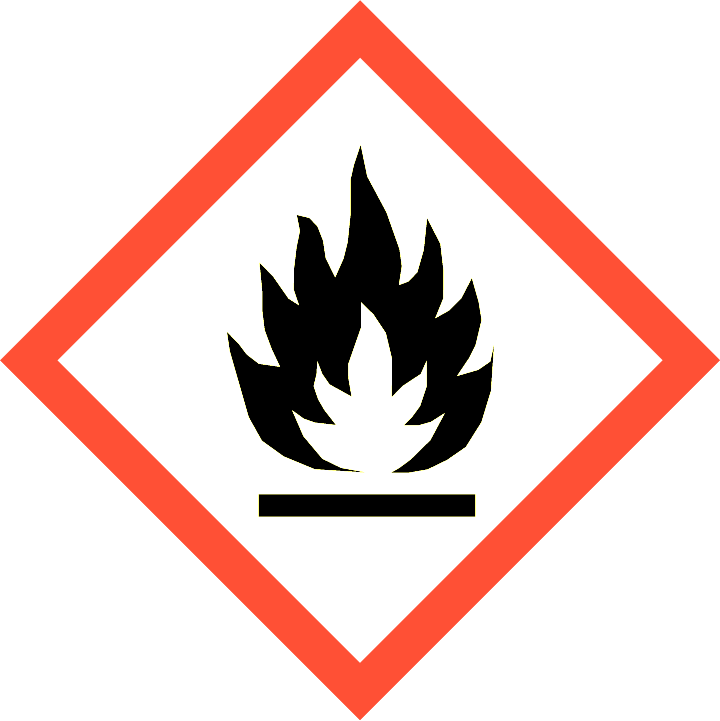 |
 |
| Flammable Gas 2 | Warning | H221 | Flammable gas | ||
| Classification & Category | Signal Word | Hazard statement | Pictograms | ||
|---|---|---|---|---|---|
| GHS/CLP | Transport | ||||
| Flammable Aerosol 1 | Danger | H222 | Extremely flammable material. |  |
 |
| Flammable Aerosol 2 | Warning | H223 | Flammable material |  |
 |
| Oxidising Gas 1 | Danger | H270 | May cause or intensify fire; oxidizer. | 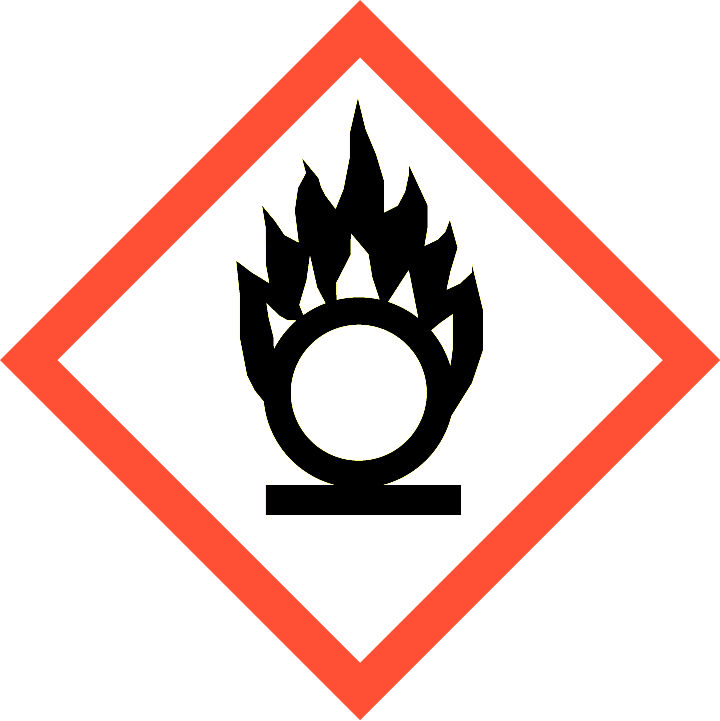 |
 |
| Compressed Gas 1 | Warning | H280 | Contains gas under pressure; may explode if heated. | 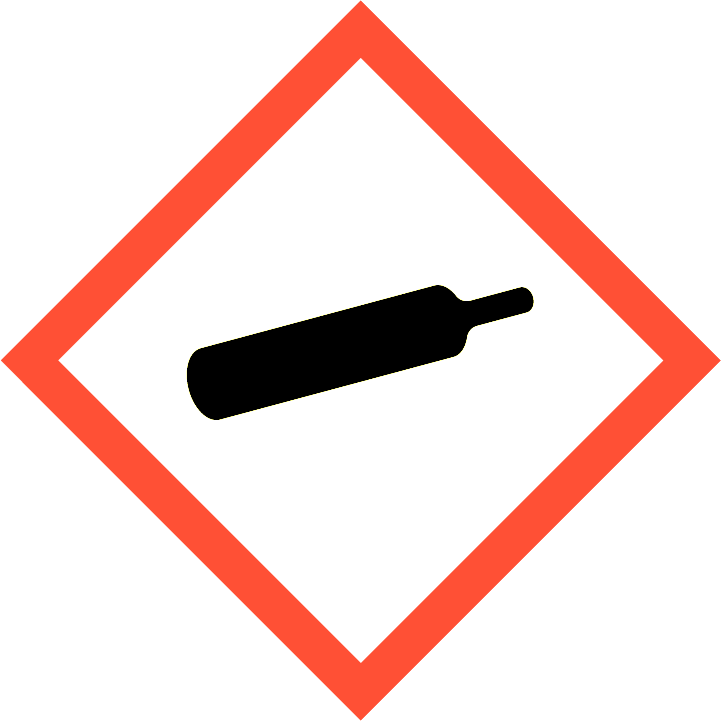 |
 |
| Liquidfied Gas 1 | Warning | H280 | Contains gas under pressure; may explode if heated. |  |
 |
| Refrigerated Gas 1 | Warning | H281 | Contains refrigerated gas; may cause cryogenic burns or injury. |  |
 |
| Dissolved Gas 1 | Warning | H280 | Contains gas under pressure; may explode if heated. |  |
 |
| Flammable Liquid 1 | Danger | H224 | Extremely flammable liquid and vapour. |  |
 |
| Flammable Liquid 2 | Danger | H225 | Highly flammable liquid and vapour. |  |
 |
| Flammable Liquid 3 | Warning | H226 | Flammable liquid and vapour. |  |
 |
| Flammable Liquid 4 | Warning | H227 | Combustible liquid | ||
| Flammable Solid 1 | Danger | H228 | Flammable solid |  |
 |
| Flammable Solid 2 | Warning | H228 | Flammable solid |  |
 |
| Self-Reactive A | Danger | H240 | Heating may cause an explosion. |  |
|
| Self-Reactive B | Danger | H241 | Heating may cause a fire or explosion. |


|


|
| Self-Reactive C/D | Danger | H242 | Heating may cause a fire. |  |
 |
| Self-Reactive E/F | Warning | H242 | Heating may cause a fire. |  |
 |
| Self-Reactive G | |||||
| Pyrophoric Liquid 1 | Danger | H250 | Catches fire spontaneously if exposed to air. |  |
 |
| Classification & Category | Signal Word | Hazard statement | Pictograms | ||
| GHS/CLP | Transport | ||||
| Pyrophoric Solid 1 | Danger | H250 | Catches fire spontaneously if exposed to air. |  |
 |
| Self-Heating 1 | Danger | H251 | Self-heating; may catch fire. |  |
 |
| Self-Heating 2 | Warning | H252 | Self-heating in large quantities; may catch fire. |  |
 |
| Water-reactive 1 | Danger | H260 | In contact with water releases flammable gases which may ignite spontaneously |  |
 |
| Water-reactive 2 | Danger | H261 | In contact with water releases flammable gas. |  |
 |
| Water-reactive 3 | Warning | H261 | In contact with water releases flammable gas. |  |
 |
| Oxidising Liquid 1 | Danger | H271 | May cause fire or explosion; strong oxidizer. |  |
 |
| Oxidising Liquid 2 | Danger | H272 | May intensify fire; oxidizer. |  |
 |
| Oxidising Liquid 3 | Warning | H272 | May intensify fire; oxidizer. |  |
 |
| Oxidising Solid 1 | Danger | H271 | May cause fire or explosion; strong oxidizer. |  |
 |
| Oxidising Solid 2 | Danger | H272 | May intensify fire; oxidizer. |  |
 |
| Oxidising Solid 3 | Warning | H272 | May intensify fire; oxidizer. |  |
 |
| Organic Perox A | Danger | H240 | Heating may cause an explosion. |  |
|
| Organic Perox B | Danger | H241 | Heating may cause a fire or explosion. |


|


|
| Organic Perox C/D | Danger | H242 | Heating may cause a fire. |  |
 |
| Organic Perox. E/F | Warning | H242 | Heating may cause a fire. |  |
 |
| Organic Perox G | |||||
| Metal Corrosive 1 | Warning | H290 | May be corrosive to metals. | 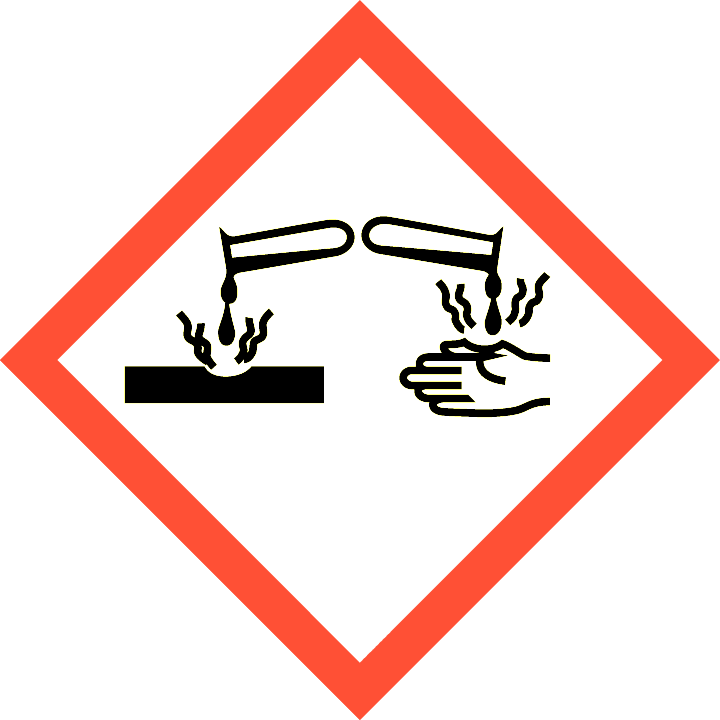 |
 |
| Classification & Category | Signal Word | Hazard statement | Pictograms | ||
|---|---|---|---|---|---|
| GHS/CLP | Transport | ||||
| Acute Toxic 1 (Dermal) | Danger | H310 | Fatal in contact with skin. | 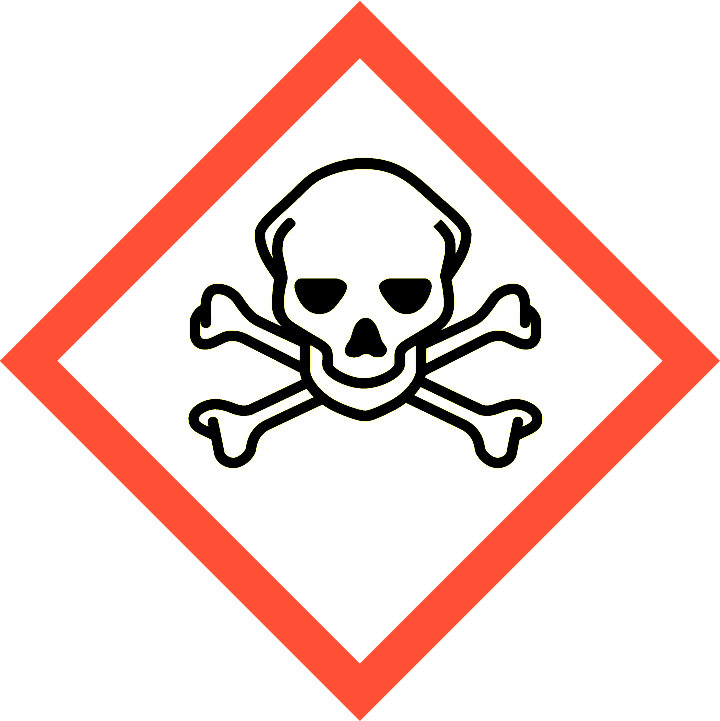 |
 |
| Acute Toxic 1 (Inhalation) | Danger | H330 | Fatal if inhaled |  |
 |
| Acute Toxic 1 (Oral) | Danger | H300 | Fatal if swallowed |  |
 |
| Acute Toxic 2 (Dermal) | Danger | H310 | Fatal in contact with skin. |  |
 |
| Acute Toxic 2 (Inhalation) | Danger | H330 | Fatal if inhaled |  |
 |
| Acute Toxic 2 (Oral) | Danger | H300 | Fatal if swallowed |  |
 |
| Acute Toxic 3 (Dermal) | Danger | H311 | Toxic in contact with skin. |  |
 |
| Acute Toxic 3 (Inhalation) | Danger | H331 | Toxic if inhaled |  |
 |
| Acute Toxic 3 (Oral) | Danger | H301 | Toxic if swallowed |  |
 |
| Acute Toxic 4 (Dermal) | Warning | H312 | Harmful in contact with skin. |  |
|
| Acute Toxic 4 (Inhalation) | Warning | H332 | Harmful if inhaled |  |
|
| Acute Toxic 4 (Oral) | Warning | H302 | Harmful if swallowed |  |
|
| Acute Toxic 5 (Dermal) | Warning | H313 | May be harmful in contact with skin. | ||
| Acute Toxic 5 (Inhalation) | Warning | H333 | May be harmful if inhaled. | ||
| Acute Toxic 5 (Oral) | Warning | H303 | May be harmful if swallowed. | ||
| Skin Corrosive 1A | Danger | H314 | Causes severe skin burns and eye damage. |  |
 |
| Skin Corrosive 1B | Danger | H314 | Causes severe skin burns and eye damage. |  |
 |
| Skin Corrosive 1C | Danger | H314 | Causes severe skin burns and eye damage. |  |
 |
| Skin Irritation 2 | Warning | H315 | Causes skin irritation |  |
|
| Classification & Category | Signal Word | Hazard statement | Pictograms | ||
|---|---|---|---|---|---|
| GHS/CLP | Transport | ||||
| Skin Irritation 3 | Warning | H316 | Causes mild skin irritation. | ||
| Eye Damage 1 | Danger | H318 | Causes serious eye damage. |  |
|
| Eye Irritation 2A | Warning | H319 | Causes serious eye irritation. |  |
|
| Eye Irritation 2B | Warning | H320 | Causes eye irritation | ||
| Respiratory Sensitiation 1 | Danger | H334 | May cause allergy or asthma symptoms of breathing difficulties if inhaled | 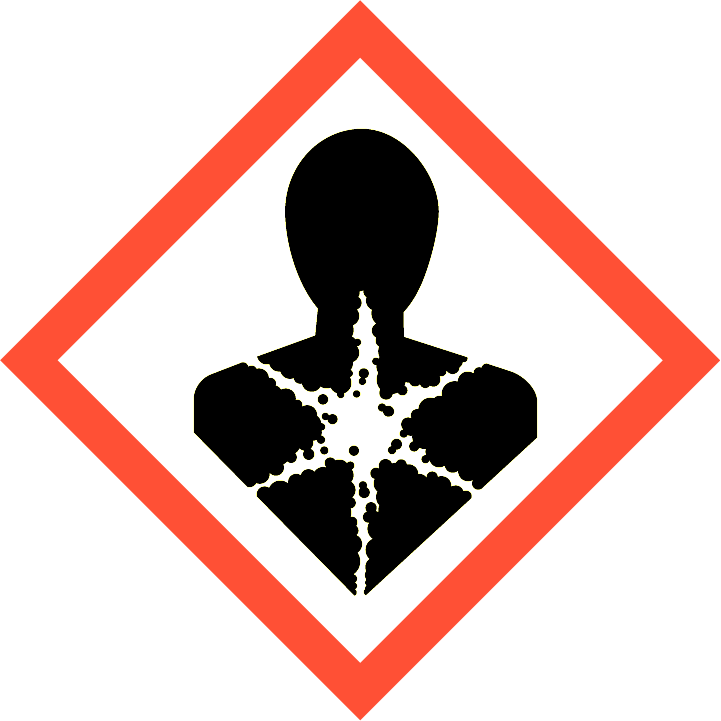 |
|
| Skin Sensitiation 1 | Warning | H317 | May cause an allergic skin reaction. |  |
|
| Germ Cell Mutagenicity 1A | Danger | H340 | May cause genetic defects <state route of exposure if it is conclusively proven that no other routes of exposure cause the hazard>. |  |
|
| Germ Cell Mutagenicity 1B | Danger | H340 | May cause genetic defects <state route of exposure if it is conclusively proven that no other routes of exposure cause the hazard>. |  |
|
| Germ Cell Mutagenicity 2 | Warning | H341 | Suspected of causing genetic defects <state route of exposure if it is conclusively proven that no other routes of exposure cause the hazard>. |  |
|
| Carcinogenicity 1A | Danger | H350 | May cause cancer <state route of exposure if it is conclusively proven that no other routes of exposure cause the hazard>. |  |
|
| Carcinogenicity 1B | Danger | H350 | May cause cancer <state route of exposure if it is conclusively proven that no other routes of exposure cause the hazard>. |  |
|
| Carcinogenicity 2 | Warning | H351 | Suspected of causing cancer <state route of exposure if it is conclusively proven that no other routes of exposure cause the hazard>. |  |
|
| Reproductive Toxicity 1A | Danger | H360 | May damage fertility or the unborn child. |  |
|
| Reproductive Toxicity 1B | Danger | H360 | May damage fertility or the unborn child. |  |
|
| Reproductive Toxicity 2 | Warning | H361 | Suspected of damaging fertility or the unborn child. |  |
|
| Reproductive Toxicity (Lactation) | H362 | May cause harm to breast-fed children. | |||
| Specific Target Organ Toxicity, Single Exposure 1 | Danger | H370 | Causes damage to organs <or state all organs affected, if known> <state route of exposure if it is conclusively proven that no other routes of exposure cause the hazard>. |  |
|
| Specific Target Organ Toxicity, Single Exposure 2 | Warning | H371 | May cause damage to organs <or state all organs affected, if known> <state route of exposure if it is conclusively proven that no other routes of exposure cause the hazard>. |  |
|
| Classification & Category | Signal Word | Hazard statement | Pictograms | ||
| GHS/CLP | Transport | ||||
| Specific Target Organ Toxicity, Single Exposure (Respiratory) 3 | Warning | H335 | May cause respiratory irritation. |  |
|
| Specific Target Organ Toxicity, Single Exposure (Narcotic) 3 | Warning | H336 | May cause drowsiness or dizziness. |  |
|
| Specific Target Organ Toxicity, Repeat Exposure 1 | Danger | H372 | Causes damage to organs <or state all organs affected, if known> <state route of exposure if it is conclusively proven that no other routes of exposure cause the hazard> through prolonged or repeated exposure. |  |
|
| Specific Target Organ Toxicity, Repeat Exposure 2 | Warning | H373 | May cause damage to organs <or state all organs affected, if known> <state route of exposure if it is conclusively proven that no other routes of exposure cause the hazard> through prolonged or repeated exposure. |  |
|
| Aspiration Hazard 1 | Danger | H304 | May be fatal if swallowed and enters airways. |  |
|
| Aspiration Hazard 2 | Warning | H305 | May be harmful if swallowed and enters airways. |  |
|
| Classification & Category | Signal Word | Hazard statement | Pictograms | ||
|---|---|---|---|---|---|
| GHS/CLP | Transport | ||||
| Aquatic Acute 1 | Warning | H400 | Very toxic to aquatic life. | 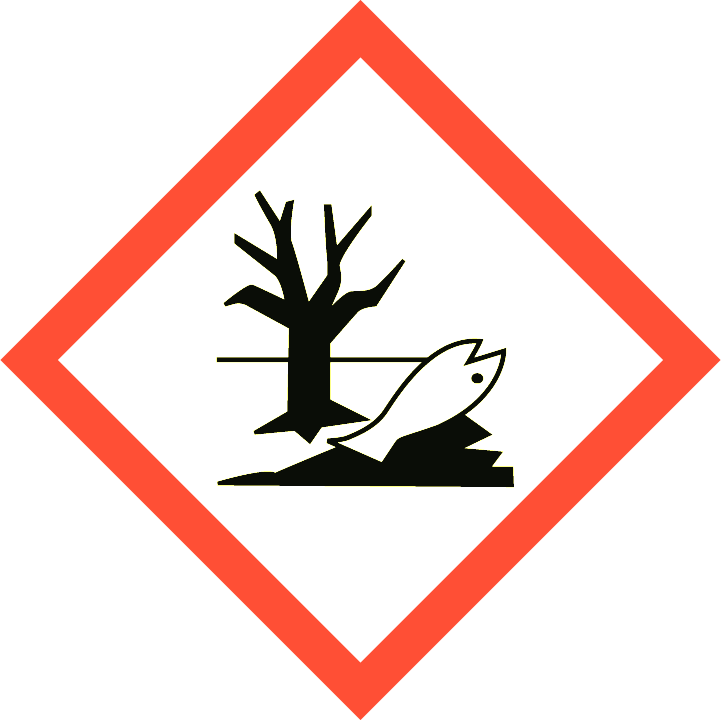 |
 |
| Aquatic Acute 2 | H401 | Toxic to aquatic life | |||
| Aquatic Acute 3 | H402 | Harmful to aquatic life. | |||
| Aquatic Chronic 1 | Warning | H410 | Very toxic to aquatic life with long lasting effects. |  |
 |
| Aquatic Chronic 2 | H411 | Toxic to aquatic life with long lasting effects. |  |
 |
|
| Aquatic Chronic 3 | H412 | Harmful to aquatic life with long lasting effects. | |||
| Aquatic Chronic 4 | H413 | May cause long lasting harmful effects to aquatic life. | |||
| Hazardous to the ozone layer | Warning | H420 | Harms public health and the environment by destroying ozone in the upper atmosphere. |  |
| EU Hazard statements | ||||||
|---|---|---|---|---|---|---|
| EUH001 | Explosive when dry |
| EUH006 | Explosive with or without contact with air. |
| EUH014 | Reacts violently with water. |
| EUH018 | In use may form flammable/explosive vapour-air mixture. |
| EUH019 | May form explosive peroxides. |
| EUH029 | Contact with water liberates toxic gas. |
| EUH031 | Contact with acids liberates toxic gas. |
| EUH032 | Contact with acids liberates very toxic gas. |
| EUH044 | Risk of explosion if heated under confinement. |
| EUH059 | Hazardous to the ozone layer |
| EUH066 | Repeated exposure may cause skin dryness or cracking. |
| EUH070 | Toxic by eye contact |
| EUH071 | Corrosive to the respiratory tract. |
| EUH201 | Contains lead. Should not be used on surfaces liable to be chewed or sucked by children. |
| EUH201A | Warning! Contains lead. |
| EUH202 | Cyanoacrylate. Danger. Bonds skin and eyes in seconds. Keep out of the reach of children. |
| EUH203 | Contains chromium(VI). May produce an allergic reaction. |
| EUH204 | Contains isocyanates. May produce an allergic reaction. |
| EUH205 | Contains epoxy constituents. May produce an allergic reaction. |
| EUH206 | Warning! Do not use together with other products. May release dangerous gases (chlorine). |
| EUH207 | Warning! Contains cadmium. Dangerous fumes are formed during use. See information supplied by the manufacturer. Comply with the safety instructions. |
| EUH208 | Contains <name of sensitising substance>. May produce an allergic reaction. |
| EUH209 | Can become highly flammable in use. |
| EUH209A | Can become flammable in use. |
| EUH210 | Safety data sheet available on request. |
| EUH401 | To avoid risks to human health and the environment, comply with the instructions for use. |
|
|